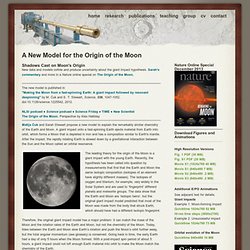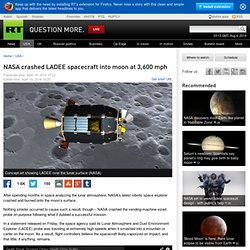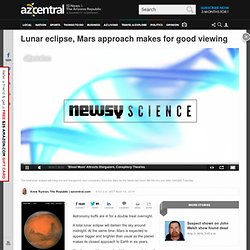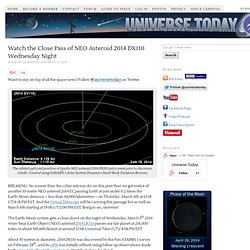

Our Electrically Scarred Moon. Sander Faas sur Twitter : "#Moon and #Venus over #Amsterdam. 'Moon rock' given to Holland by Neil Armstrong and Buzz Aldrin is fake. Curators at Amsterdam's Rijksmuseum, where the rock has attracted tens of thousands of visitors each year, discovered that the "lunar rock", valued at £308,000, was in fact petrified wood.

Xandra van Gelder, who oversaw the investigation, said the museum would continue to keep the stone as a curiosity. "It's a good story, with some questions that are still unanswered," she said. "We can laugh about it. " The rock was given to Willem Drees, a former Dutch leader, during a global tour by Neil Armstrong, Michael Collins and Edwin "Buzz" Aldrin following their moon mission 50 years ago. J. "I do remember that Drees was very interested in the little piece of stone. Nasa gave moon rocks to more than 100 countries following lunar missions in 1969 and the 1970s. The United States Embassy in The Hague is carrying out an investigation into the affair.
"It's a nondescript, pretty-much-worthless stone," said Frank Beunk, a geologist involved in the investigation. Origin of the Moon. Shadows Cast on Moon's Origin New data and models collide and produce uncertainty about the giant impact hypothesis.

Sarah's commentary and more in a Nature online special on The Origin of the Moon. The new model is published in "Making the Moon from a fast-spinning Earth: A giant impact followed by resonant despinning" by M. Ćuk and S. T. NLSI podcast ♦ Science podcast ♦ Science Friday ♦ TIME ♦ New ScientistThe Origin of the Moon, Perspective by Alex Halliday. Matija Ćuk and Sarah Stewart propose a new model to explain the remarkably similar chemistry of the Earth and Moon. Rt. Published time: April 18, 2014 17:22 Edited time: April 19, 2014 15:25 Concept art showing LADEE over the lunar surface (NASA) After spending months in space analyzing the lunar atmosphere, NASA’s latest robotic space explorer crashed and burned onto the moon’s surface.

Nothing sinister occurred to cause such a result, though – NASA crashed the vending-machine-sized probe on purpose following what it dubbed a successful mission. In a statement released on Friday, the space agency said its Lunar Atmosphere and Dust Environment Explorer (LADEE) probe was traveling at extremely high speeds when it smashed into a mountain or carter on the moon. As a result, flight controllers believe the spacecraft likely vaporized on impact, and that little, if anything, remains. "At the time of impact, LADEE was traveling at a speed of 3,600 miles per hour – about three times the speed of a high-powered rifle bullet," said NASA project scientist Rick Elphic. Lunar eclipse, Mars approach makes for good viewing. Astronomy buffs are in for a double treat overnight.

A total lunar eclipse will darken the sky around midnight. At the same time, Mars is expected to appear bigger and brighter than usual as the planet makes its closest approach to Earth in six years. Weather permitting, you should have a good view of the Red Planet as it orbits 57 million miles from Earth. The reddish-orange dot can be seen with the naked eye, visible in the east-southeast after sunset. The total lunar eclipse will last 78 minutes, but the brilliance of Mars will be visible much longer. "As long as the skies remain clear ... it will be a nice show for many weeks," said Arizona State University professor Jim Bell, a planetary scientist and Mars researcher at the School of Earth & Space Exploration.
Mars comes close enough for remarkable viewing only once or twice every 15 or so years, according to NASA. Dark, rural areas are the best places for viewing. Amateur astronomers have been focusing on Mars for several days. Watch the Close Pass of NEO Asteroid 2014 DX110 Wednesday Night. Want to stay on top of all the space news?

Follow @universetoday on Twitter The orbital path and position of Apollo NEO asteroid 2014 DX110 just a week prior to discovery. Credit- Created using NASA/JPL’s Solar System Dynamics Small-Body Database Browser. BREAKING- No sooner than the cyber-ink was dry on this post than we got notice of another 10-metre NEO asteroid 2014 EC passing Earth at just under 0.2 times the Earth-Moon distance – less than 64,000 kilometres – on Thursday, March 6th at 21:18 UT/4:18 PM EST. And the Virtual Telescope will be carrying this passage live as well on March 6th starting at 19:00 UT/2:00 PM EST. The Earth-Moon system gets a close shave on the night of Wednesday, March 5th 2014 when Near Earth Object (NEO) asteroid 2014 DX110 passes our fair planet at 216,000 miles or about 345,600 distant at around 21:06 Universal Time (UT)/ 4:06 PM EST. The webcast of the event is expected to go live at 20:30 UT, and will include live commentary. About David Dickinson.